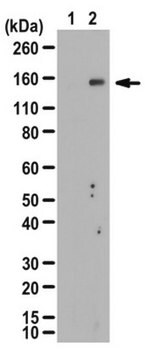MABF244
Anti-PAR-1, clone ATAP2 Antibody
clone ATAP2, from mouse
Synonym(e):
Proteinase-activated receptor 1, PAR-1, Coagulation factor II receptor, Thrombin receptor
About This Item
Empfohlene Produkte
Biologische Quelle
mouse
Qualitätsniveau
Antikörperform
purified immunoglobulin
Antikörper-Produkttyp
primary antibodies
Klon
ATAP2, monoclonal
Speziesreaktivität
human, mouse
Methode(n)
flow cytometry: suitable
immunocytochemistry: suitable
immunofluorescence: suitable
western blot: suitable
Isotyp
IgG1κ
NCBI-Hinterlegungsnummer
UniProt-Hinterlegungsnummer
Versandbedingung
wet ice
Posttranslationale Modifikation Target
unmodified
Angaben zum Gen
human ... F2R(2149)
Allgemeine Beschreibung
Immunogen
Anwendung
Flow Cytometry Analysis: A representative lot from an independent laboratory detected Par-1 in CHRF-288 and HEL cells (Hoxie, J. A., et al. (1993). J Biol Chem. 268(18):13756-13763.).
Western Blotting Analysis: A representative lot from an independent laboratory detected Par-1 in human platelet membrane cell lysate (Brass, L. F., et al. (1992). J Biol Chem. 267(20):13795-13798.).
Immunocytochemistry Analysis: A representative lot from an independent laboratory detected Par-1 in CHRF-288 and HEL cells (Hoxie, J. A., et al. (1993). J Biol Chem. 268(18):13756-13763.).
Immunofluorescence Analysis: A representative lot from an independent laboratory detected Par-1 in CHRF-288 cells (Brass, L. F., et al. (1994). J Biol Chem. 269(4):2943-2952.).
Qualität
Western Blotting Analysis: 1 µg/mL of this antibody detected Par-1 in 10 µg of mouse lymph node tissue.
Zielbeschreibung
Physikalische Form
Sonstige Hinweise
Sie haben nicht das passende Produkt gefunden?
Probieren Sie unser Produkt-Auswahlhilfe. aus.
Lagerklassenschlüssel
12 - Non Combustible Liquids
WGK
WGK 1
Flammpunkt (°F)
Not applicable
Flammpunkt (°C)
Not applicable
Analysenzertifikate (COA)
Suchen Sie nach Analysenzertifikate (COA), indem Sie die Lot-/Chargennummer des Produkts eingeben. Lot- und Chargennummern sind auf dem Produktetikett hinter den Wörtern ‘Lot’ oder ‘Batch’ (Lot oder Charge) zu finden.
Besitzen Sie dieses Produkt bereits?
In der Dokumentenbibliothek finden Sie die Dokumentation zu den Produkten, die Sie kürzlich erworben haben.
Unser Team von Wissenschaftlern verfügt über Erfahrung in allen Forschungsbereichen einschließlich Life Science, Materialwissenschaften, chemischer Synthese, Chromatographie, Analytik und vielen mehr..
Setzen Sie sich mit dem technischen Dienst in Verbindung.